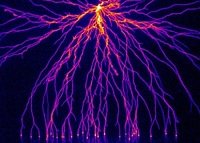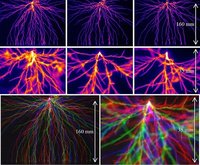Streamers - electrically conducting channels in gases like air - occur in the early stages of lightning, and in industrial applications. On their behaviour in different types of gas mixtures was not much known yet. Gideon Wormeester, PhD student from Centrum Wiskunde & Informatica (CWI) in Amsterdam, extended the streamer models and explained some new phenomena. On 29 August he defends his PhD thesis 'Propagation Mechanisms of Positive Streamers in Different Gases' at Eindhoven University of Technology. Streamer research has applications in the lighting industry, cleaning of smoke gases, in the biomedical field and for example in making energy-efficient switches for energy companies.
Electron Avalanche
"I sometimes compare the streamer’s functioning with a nail," says Gideon Wormeester. "With a hammer, I cannot make a hole in solid wood, but with a nail I can get through. Air conducts electricity poorly, and the average field strength in a thundercloud alone is not enough to start up lightning. With their sharp points of ions or electrons, streamers can help making an ionized path to the earth, after which lightning can take place."
Wormeester studied the propagation of streamers in mixtures of nitrogen and oxygen, and in pure nitrogen. "Theoretically positive streamers cannot exist in pure nitrogen at all but in practice they appeared to emerge anyway. With my models I showed that a contamination of only one oxygen molecule in a million nitrogen molecules was enough to generate an electron avalanche. Now I can say to both industry and academia that for some purposes ‘pure gas’ does not exist, since the smallest unavoidable impurities will make a real difference.

Wormeester also extended the CWI software to simulate the streamers - ARCoS. This software is now open source available online. The results can possibly be applied to develop stadium lights that are more energy-efficient, painless electrical wound disinfection with cold plasmas and environmentally friendly high voltage switches. The research was partly funded by STW and is performed in the Multiscale Dynamics research group at CWI. Energy is one of the key research areas of the Amsterdam based Centrum Wiskunde & Informatica.
More information:
- the homepage of the Multiscale Dynamics research group at CWI
- the ARCoS (Adaptive Refinement Code for Streamers) software
Illustration 1: New simulations from CWI can explain more details in the behaviour of streamers, which occur in the early stages of lightning. Here a simulation of the electrical field strength of a streamer in air (source: CWI).
Illustration 2: Streamers in pure nitrogen in an Eindhoven experiment (courtesy S. Nijdam, TU/e). Wormeester explained streamer behaviour with his new simulations.
Illustration 3: The last picture of the photo series below shows - in different colours - the formation of streamers at different moments in time (courtesy S. Nijdam, TU/e). This illustration appeared in J. Phys. D: Appl. Phys 44 (2011) 455201.

